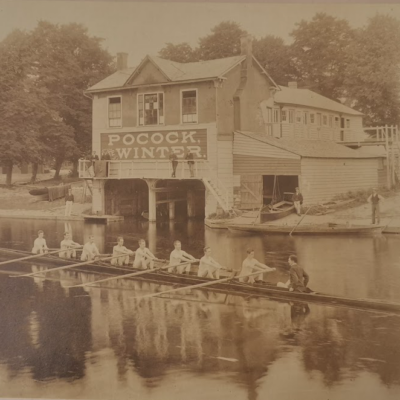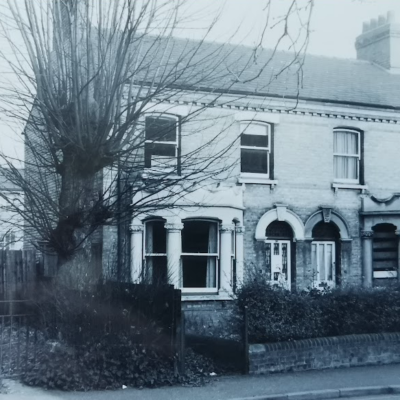Search by topic
- archaeology
- Building of Local Interest
- charity
- church
- crime
- dressmaker
- fire
- Great Eastern Railway
- Listed building
- Mapping Relief
- medieval
- oral history
- poverty
- Public House
- Rattee & Kett
- Religious House
- Roman
- scholar
- school
- Then and Now
- tudor
- women
- work
- world war one
- world war two
Search by text
165 Chesterton Road
History of 165 Chesterton Road
Edward Katon was living here in 1949. He had previously lived at 4 Sunnyside. He married Joyce Mansfield of 11 Darwin Drive in 1950 and moved to 21 Devonshire Road.
He wrote detailed diaries of his life and Capturing Cambridge reproduces extracts from these:
University bumps take place on the River Cam in June and are known as the May bumps. The ‘May’ is another name for the Hawthorn Bushes which grow along the banks of the Cam.
The town bumps take place at the end of July. Crews come from shops, factories and all over Cambridge but not the colleges. The rowing boats hired from them.
It was 1949 when I joined the Pye Company Boat Club. A company that made radios, television sets, radio telephones, aircraft blind landing systems, etc. A newcomer to racing rowing I found it hard work but the ultimate in teamwork. Eight men have to row as one and takes weeks of practice. Our tutors were college tutors who taught voluntarily. The bumps took place on the last four days in the last week of July.
When a river is too narrow for boats to race side-by-side there are two options. (1) The races where boats set off at minute intervals over a course of one eg one mile. (2) Bumps races where both start off with is a set distance between them. As the starting gun fires all crews start rowing was the object of (literally) bumping the boat in front of it before the boat behind it can bump them. Each boat has a rubber ball (size of a tennis ball) on its prow and also has a round piece of wood with hole in the centre. It’s rim painted and this gives it priority over other craft on the river. When practicing before ?? ?? it can only be used one way on the river which is the direction of the race. Other river craft are supposed to give way including other ‘eights.’ When you have made your ‘bump’ or been bumped by a following boat, your part in the race is finished for that night. You have to get to the river bank and out of the way of following boats. Your teacher and coaches ride alongside you on bicycles and shout instructions through megaphones to your cox (coxswain) who steers the boat and gives his oarsmen (rowers) the orders. During a race the towpath on one side of the river and spaces on the other side are always full of spectators. There is no charge or fee for watching except maybe on private land. All the boats are separated into ‘divisions’ of not more than 18 boats each, and numbered from the first one downwards. The last division rows first, and whoever comes first boat in that race becomes the last boat in the next race and is known as the ‘sandwich’ boat. In following races the ‘sandwich’ boat exchanges places with the last boat of the latter division if it bumps it, if not it stays head of the last division or until next year if it is Friday’s race. The object of bumping is to exchange places with the boat in front of you and work your way up to the top. You can only bump one boat each night, however if the boat in front of you has already bumped the boat in front of it, you are allowed to try to bump the next boat. This is called an over bump and count as three bumps. You go up three places the next night. If your crew make 4 clear bumps over the four nights rowing you win the oar you are rowing with. It is yours to keep as a trophy. Four clear bumps are classed as follows: if your crew make 4 bumps and are bumped over you only have three clear bumps so don’t win your oar. Bump 6 times and get bumped twice is 6 – 2 = 4 ‘clear’ bumps and you win your oar and the cox gets the rudder. Students love to win two oars (over 2 years) and place crossed oars on the wall in their home. Amateurs were usually given an old oar which could be converted into a standard lamp. When I left rowing later in the season there was talk of miniature 2 foot-long presentation tools coming into fashion.
Memoirs of Cambridge
Town bumps 1949
The town bumps are rowing races what take place on rivers that are too narrow for boat to row abreast for the full course. The town bumps take place in the final four days in the last whole week in July. We were the Pye third boat. Boats and equipment are hired from the colleges and coaches, usually two, give their time freely. We trained each night from 7 p.m. to 8 p.m. sometimes later. It was hard work but great teamwork. Eight men have to row as one. Saturday afternoons were we went on long trips sometimes Baits Bite lock and further up the Cam. We called ourselves ‘The Pirates.’ Someone made a pirate flag, all black with a white skull and cross bones on each side. Someone else cut ‘Pye’ out from an old box and this was fixed to the front of the boat on the ‘priority course sign.’ This is a 12’’ disk with a ?? ?? in the centre and one white circle painted round the edge can be used in training and all river traffic has to give way to it as the boat will be travelling at maximum speed and cannot stop quickly. The sign only be used one way, and that is a from Baits Bite lock to the boat houses. The bumps start with the position your boat (not crew) finished last year. New boats go to the rear. One length of boat between each boat and crews must be amateurs. So many take part that they are divided into ‘divisions’ and the lower divisions start first. You move upwards in the table by bumping a boat in front of you. You can only make one bump each night, although if the boat in front has made its bump you are allowed to try and bump the next bump. If you succeed it is called an over bump and counts as three bumps. Any boat that is bumped has to take the place that bumped it. Boats that have been bumped or been bumped and must get to the nearest river bank out of the other boats’ way. The only exception is the boat which finishes the race at the top of its division, which has to return to the start at the bottom of the next division and is known as the ‘sandwich’ boat.
On the first night we were caught at the halfway point. The Pye sign and the pirate flag were blamed for being a drag on the boat. The Pye sign was dispensed with and the pirate flag not flown during a race but at all other times. The second night ww were all determined to have a good hard row and bump the boat had bumped. The superstitious ones found a beetle with long antennae and declared it a good luck sign. The starting is in three phases. (1) The starting guns are two small about 12 inches long and fire simultaneously (two guns in case one does not fire) and fire 5 minutes to alert crews and spectators. (2) The second gun are fired with one minute to go and you get into the boats and use the oars near the bank to push the boat into midstream, helped by the boatman from the college your boat is from using his boat hook to push you out. (3) When the third time the guns fired it was the start. To make sure you were in the correct place the cox had to hold a wooden budge[?] attached to chain joined to a stake on the bank. We went off like a shot from a gun. Our target in front was in trouble. Had caught his boat hook in the rigger, which holds the oar enabling it to swing. Once he freed that we were able to start. Their number 8 oarsman ‘stroke’ who sets the pace, caught a crab with his first stroke. His oar went in slantwise down in the river instead going in square and pushing the boat along. By this time we’re at full speed coming towards theirs and the only thing was to get out of our way as you cannot stop suddenly. All our oars on the offside hit theirs on the nearside. The order to stop rowing was given. We all thought the boat we had hit had gone down early to watch the start and were shouting to get on with the race. Easy, easy Pye shouted our coach through a megaphone. You’ve had your bump. We were disappointed that we had made a bump so early. We raised the pirate flag but the traditional piece of hawthorn on the front of the boat and a piece with flowers, down the cox’s neck and rowed home to the excitement of the small boys (we had a (brown) coloured man in a crew) and the cheers of the crowd. The next night they caught us back again. The fourth night they were bumped and the boat further behind bumped us after we had gone no more than 300 yards and moaned that we had taken them twice as far as the previous ones had done. When the four nights racing is finished crowds rush to the boat houses to see the boats lifted out of the water, after the oars are first taken to the boathouse, then the boat and finally the cox thrown in the river. While I was helping to throw the cox in Help and I were pushed. When I came out a laughing crewmen said as you went in someone was running to push you in and went in clean over the top of you. After the race our coaches took us back to their college to a nice tea with salad and liquid refreshment and we gave them each a table lamp made from an oar. A good time was had by all.
Contribute
Do you have any information about the people or places in this article? If so, then please let us know using the Contact page or by emailing capturingcambridge@
License
This work is licensed under CC BY-NC-SA 4.0








